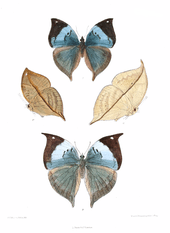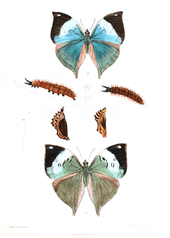Kallima horsfieldii
| South Indian blue oakleaf | |
|---|---|
| | |
| Scientific classification | |
| Kingdom: | Animalia |
| Phylum: | Arthropoda |
| Class: | Insecta |
| Order: | Lepidoptera |
| Family: | Nymphalidae |
| Genus: | Kallima |
| Species: | K. horsfieldii |
| Binomial name | |
| Kallima horsfieldii Kollar, 1844 | |
The South Indian blue oakleaf (Kallima horsfieldii) is a nymphalid butterfly found in India. The underside appears like a leaf complete with midrib while the upperside is brilliantly coloured.
Description
Dry-season form

Males and females indigo-blue. Forewing; with a broad, oblique, slightly curved, sinuous-edged, pale blue band, turning to white on the anterior half; the distance measured on the costa of the outer edge of thin band greater than half the length of the wing from the base; its inner margin bordered by short, obliquely-placed, detached linear black markings; apical area beyond the band jet-black, with a preapical whites spot; medial hyaline spots, the lower varying in size, in interspaces 2 and 3. Hindwing uniform, the costa and apex broadly and the abdominal fold brown; vein 1 with long soft greyish-brown hairs along its length,extending also over the abdominal fold. Forewings and hindwings as in Kallima inachus, with a dark brown subterminal zigzag line, commencing below vein 3 on the forewing.
Underside as in Kallima inachus simulating a dry leaf, but the resemblance on the whole is perhaps less perfect. Antennae dark brown; head, thorax and abdomen very dark greenish brown; beneath, the palpi, thorax and abdomen ochraceous earthy brown.
Wet-season form

Males and females similar. Differs in the colour of the discal band on the upperside of the forewing; this is of a uniform pale blue of a slightly lighter or darker shade, varying individually, but not turning to white towards the costal margin as in the dry-season specimens. Underside: ground colour on the whole darker than in the dry-season form, but with the same protective colouring.[1]
Wingspan 84-120 mm.
Ceylon dry-season specimens range the largest, but are otherwise indistinguishable from specimens from the Nilgiris in the British Museum collection, while specimens of the small wet-season form from Ceylon are absolutely identical with specimens of K. wardi Moore, regarded by the author himself as the wet-season form of K. horsfieldi. Again, the type of K. alompra Moore, is now in the British Museum, and in shades of colour and in markings it is absolutely inseparable from many specimens of the wet-season form of horsfieldii as are also the two specimens in the Hewitsonian collection mentioned by Moore, and a specimen from; East Pegu, collected by Doherty, in the Godman-Salvin collection.
Distribution
Western Ghats from Bombay southwards; Ceylon; Burma; Tenasserim.[1]
Larva
"Cylindrical, finely pubescent, armed with nine longitudinal rows of fine branched spines; head surmounted by two long straight horns set with minute spines; colour a beautiful golden brown, spines red, head black. We found one specimen of this in July on Karvee (Strobilanthes)... " (Davidson & Aitken)[1]
Pupa
Earthy brown suffused with a slight pinkish tinge and variegated with patches of darker brown; thorax angulate, abdomen with apparently a linear series of short broad tubercles. (Described from the plate in the Bombay Nat. Hist. Soc. Journ. x, 1896.)[1]
References
- 1 2 3 4 Bingham, C.T. (1905). The Fauna of British India, Including Ceylon and Burma Butterflies. 1 (1st ed.). London: Taylor and Francis, Ltd.